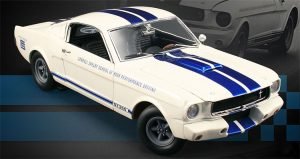When it comes to the subject of diecast model cars, there’s not much more important than the matter of scale. There seems to be a bewildering number of choices when it comes to this subject and it can be very confusing for anyone who is starting to think about collecting them or buying one as a gift for a loved one. That’s why I thought I would try and clear things up a little with my handy guide to scale – what it means and how it affects detail and pricing etc. Enjoy.
So lets start by considering the different Scales
Let’s start with a definition: Scale ( skal ) n. –
A proportion used in determining the dimensional relationship of a representation to that which it represents ( Answers.com )
Diecast cars come in many different scales from small 1:64 scale models to large 1:12 scale models. Often you will see scale denoted in different ways. The most common two ways are using the forward slash ” / ” and the colon ” : ” We will use them interchangeably in this article. Scale is a fractional representation of the size of a model in comparison with the real car. So, a 1:18 scale diecast car for example will be 1/18th the size of a real car. Every 18 inches of the real car will be represented by 1 inch of a scale diecast car.
 The easiest way to visualize this is through an example. Using a 1/18 scale diecast car, let’s compare it to a real car. If we take the popular 1965 Ford Mustang GT 350 Shelby with dimensions of
The easiest way to visualize this is through an example. Using a 1/18 scale diecast car, let’s compare it to a real car. If we take the popular 1965 Ford Mustang GT 350 Shelby with dimensions of
181.61 in. long x
68.18 in. wide, we can calculate the size of the 1:18 scale model.
181.61 in. * 1/18 = 10.089 in. long
68.18 in. * 1/18 = 3.788 in. wide
The approximate size of the 1/18 scale model would be 10.089 in. long x 3.788 in. wide. The actual measurements will vary based upon how accurately the real car is modeled and how close the tooling is from the diecast manufacturer.
Why have different scales?
Well, a lot of collectors enter the hobby at a young age collecting matchbox size cars around 1:64 scale. These are great entry level models because you can collect hundreds of them and still store them easily. They are also usually cheaper and more readily available. Some collectors stay with this scale and others move on to larger models.
Larger models often offer a better representation of the 1:1 car than the smaller ones. Having a larger canvas allows manufacturers to more accurately model the cars. This is just a general rule of thumb as we’ve seen plenty of 1:24 scale replicas that are far more accurate than their 1:18 scale counterparts. While we’re on general rules of thumb, the larger scale models usually cost a little more than a similarly detailed smaller scale model.
Often this price difference, level of detail, and space restrictions will dictate which scale a collector chooses and how many he or she can collect. One of the most popular scales of larger diecast cars is the 1:18 scale that we talk about so much. This scale can incorporate all the detail you could want while still being small enough to collect hundreds in one room.
The 1:18 scale diecast world also has many manufacturers producing replicas for collectors to enjoy. From muscle cars to exotics, there is something for everyone. Collectors often opt to collect only one or two different scales so choosing the one that’s right for you can help steer your collection in the right direction from the beginning, but don’t feel limited by one scale. Just as some collectors choose to stay with one, others may opt to collect only one brand of car. If you’re a diehard Chevrolet Camaro fan, then you may want to get all the Camaros you can find in any scale available.
Collecting is a hobby that we all do to make us happy. You know better than anyone what you like so don’t feel limited by scales or manufacturers, just get to collecting and enjoy everything the hobby has to offer you.
